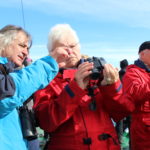Adjust your binoculars and get ready for bird watching
As one of the fastest-growing outdoor activities, bird watching, is also one of the most contagious trends while expedition cruising. Using the 360-degree outdoor platforms of One Ocean Expeditions’ vessels, which are partially covered, it is easy to fall for this wildlife spectacle. In recent voyages, it became clear that passengers benefitted from receiving “binocular focusing” instructions.



How To Properly Focus Binoculars
There’s no better way to enjoy the wonders of our natural world than with a good pair of binoculars.
You’ll want something that’s comfortable, sturdy and provides a bright, clear view. The most popular models used by birders range between 7 & 10 power magnification. 8 power is the magnification used by most birders, and they’re especially good for beginners since higher magnifications can be more difficult to use without steady hands and some prior experience. But, to get the most out of any binocular, you must first properly calibrate them for your personal vision. Each of us has a slight difference in the way our eyes focus. So every time you use a new or different binocular, you should do the following adjustments:
We’ll use the Nikon 8 X 42 binoculars as our reference. They magnify 8 times. The outer (objective) lens is 42mm across.
Step 1 – The best binoculars for birding have a central focus knob, and one focusing eyepiece. Determine which of the two barrels of the binocular has the focusing eyepiece. Nikons have the eyepiece adjustment on the right barrel.
Step 2 – Look through the binocular and adjust the two barrels about the hinge until it fits comfortably against your eyes.
Step 3 – Pick a stationary reference spot at about 10 or 15 meters away (eg: tree trunk or street sign). Shut the right eye (the eye corresponding to the focusing eyepiece) and focus with the central focus knob. Once your reference point is 100% in focus, take your hands away from the focusing knob and don’t touch it until the adjustment is complete.
Step 4 – From the same vantage point, shut the left eye, and focus the right barrel using the eyepiece adjustment knob. Once your reference spot is 100% in focus, take your hands away from the eyepiece adjuster.
Both barrels should now be perfectly adjusted to your vision. And, both eyes should simultaneously achieve perfect focus by only adjusting the central focusing knob. Eyeglass wearers should put the eye cups down when using binoculars. This brings your eyes to the correct distance from the eyepieces and maximizes the quality of the view. Not all models have the same focusing system. So, check your owner’s manual and follow the advice provided by the manufacturer.
Our world is filled with wonder and beauty. It’s out there just waiting to be discovered by you. Enhance your views with a pair of high-quality binoculars. And, make sure they’re properly focused. © Tony Beck
CLICK HERE for Tony Beck’s video tutorial on how to adjust your binoculars properly.

Tony Beck, Ornithologist and Photographer
A field expert in ornithology and photography, Tony is an enthusiastic, skilled and popular guide with One Ocean Expeditions. Tony has perfected his teaching skills in birdwatching and photography in his 30+ years of experience guiding tours. His award-winning work appears in many books, field guides, websites, magazines & calendars.
Every passenger receives a complimentary pair of waterproof NIKON binoculars for the duration of their voyage with One Ocean Expeditions.
Looking for more information? Our agents have extensive experience and knowledge of the areas we visit. Speak with your travel agent or call our experts to learn more.
Give us a call or send through an email.















